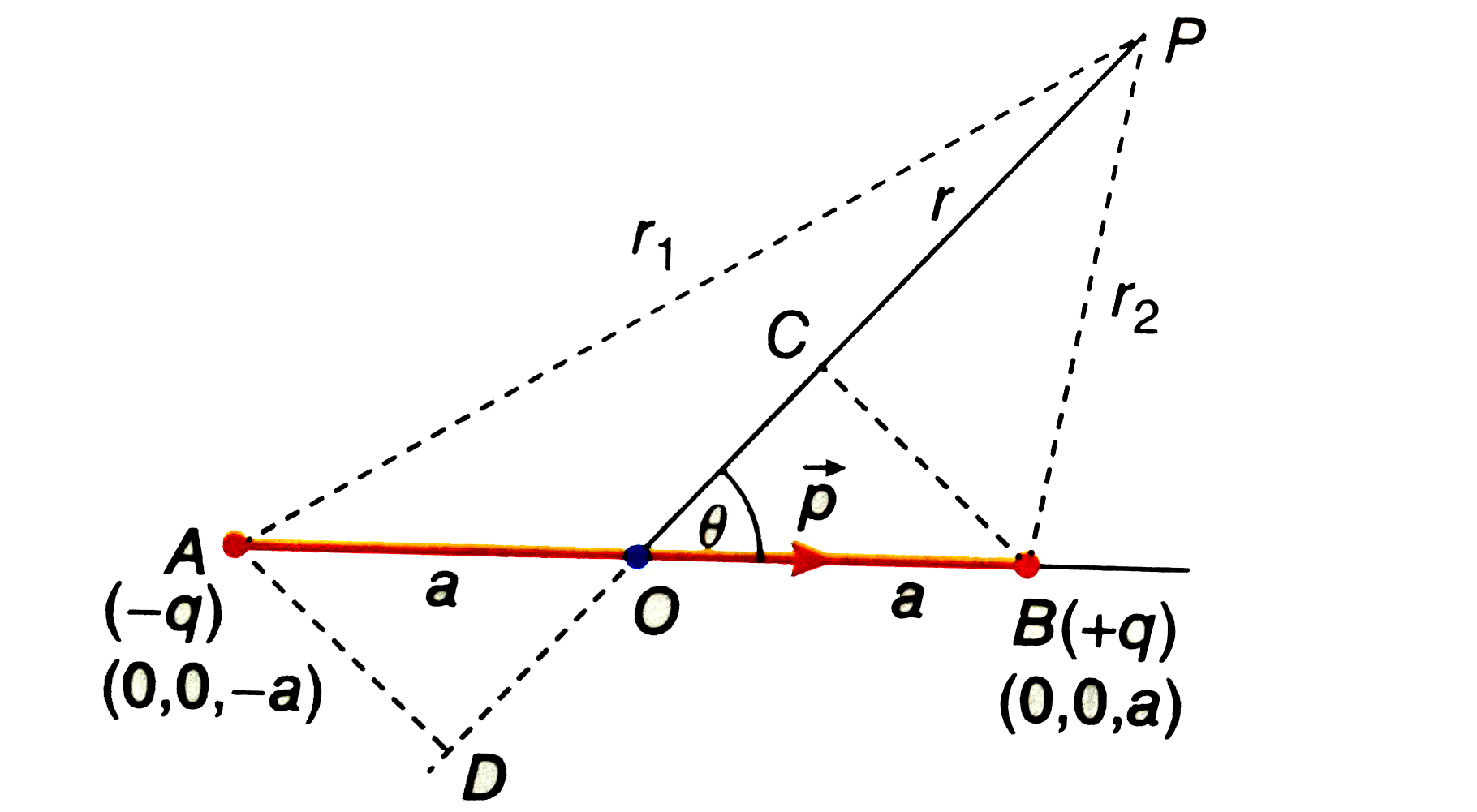Two charges -q and +q are located at points (0,0,-a) and (0,0,a) respectively.
(b) Obtain the dependence of potential on the distance r of a point from the origin when r>>a.Solution in Bengali
Let P be the point at a distance r from the dipole. OP makes an angle θ with the axis of the dipole. The length of the dipole = 2a.
r2=BP≈CP=r−acosθ
r1AP≈DP=r+acosθ
Potential at P,
V=V1+V2=q4πε0(1r2−1r1)
=q4πε0(1r−acosθ−1r+acosθ)

∴V=q4πε02acosθr2−a2cos2θ
=2aqcosθ4πε0{1r2(1−a2r2cos2θ)−1}
≈pcosθ4πε0r2[∵a2r2<<1]
∴V∝1r2.
Topper's Solved these Questions
- BOOK - CHHAYA PUBLICATIONCHAPTER - ELECTRIC POTENTIAL EXERCISE - NCERT examplar questions with answer hint (MCQ -1 single option correct)3videos
ELECTRIC POTENTIAL
- BOOK - CHHAYA PUBLICATIONCHAPTER - ELECTRIC POTENTIAL EXERCISE - NCERT examplar questions with answer hint (MCQ -2 Multiple options correct)3videos
ELECTRIC POTENTIAL
- BOOK - CHHAYA PUBLICATIONCHAPTER - ELECTRIC POTENTIAL EXERCISE - Higher order thinking skill (HOTS) questions23videos
ELECTRIC POTENTIAL
- BOOK - CHHAYA PUBLICATIONCHAPTER - ELECTRIC FIELDEXERCISE - CBSE SCANNER31videos
ELECTRIC FIELD
- BOOK - CHHAYA PUBLICATIONCHAPTER - ELECTROMAGNETIC INDUCTION & ALTERNATING CURRENTEXERCISE - CBSE SCANNER28videos
ELECTROMAGNETIC INDUCTION & ALTERNATING CURRENT
Similar Questions
A positively charged particle is released from rest in a uniform electric field. The electric potential energy of the charge
03:17View SolutionEquipotential surfaces
03:19View SolutionIf the intensity at a point in an electric field is zero, will the electric potential be also zero at that point? If the electric potential be zero at a point, will the intensity be also zero at the point?
10:22View SolutionA charge q is placed at the centre of a cube of side l. What is the electric flux passing through each face of the cube?
02:11View SolutionA bar magnet is moved in the direction indicated by the arrow between two coils PQ and CD. Predict the directions of induced current in each coil.
 View Solution
View SolutionTwo charges -q and +q are located at points (0,0,-a) and (0,0,a) respectively. (i) What is the electrostatic potential at the points at the points (0,0,z) and (x,y,0)? (ii) Obtain the depentence of potential on the distance r of the point form the origin, when (r)/(a) gt gt 1 . (iii) How much work is done in moving a small test charge from the point (5,0,0) to (-7,0,0) along the x-axis. Does the answer charge if path of test charge between the same points is not along the x-axis ?
06:19View SolutionTwo point charges −q and +q are located at points (0,0−a) and (0,0,a) resepctively.The electric potential at point (0,0,z)is (Z>a)
07:07View Solutionबिंदु(0,0,-1) तथा (0,0,a) पर दो आवेश क्रमशः - q और +q स्थित है |
बिन्दुओ (0,0,z) और (x,y,0) पर स्थित विद्युत विभव की क्या है ?03:24View Solutionबिंदु(0,0,-1) तथा (0,0,a) पर दो आवेश क्रमशः - q और +q स्थित है |
मूलबिंदु से किसी बिंदु की दुरी r पर विभव की निर्भरता ज्ञात कीजिए , जबकि r/a>>1 है |07:20View SolutionTwo charges -q and +q are located at points (0,0-a) and (0,0-a), respectively. (a) What is the electrostatic potential at the points (0,0,z) and (x,y,0) ? (b) Obtain the dependence of potential on the distance r of a point from the origin when r//a gt gt1. (c) How much work is done in moving a small test charge from the point (5,0,0) to (-7,0,0) along the x-axis? Does the answer change if the path of the test charge between the same points is not along the x-axis ?
View SolutionTwo charges -q and +q are located at points (0,0,-a) and (0,0,a) respectively.
(a) What is the electrostatic potential at the points (0,0,z) and (x,y,0) ?View Solutionबिन्दु (0, 0, - a) तथा (0, 0, a) पर दो आवेश क्रमश:-q और +q स्थित हैं।
मूलबिन्दु से किसी बिन्दु की दूरी r पर विभव की निर्भरता (dependency) ज्ञात कीजिए, जबकि ra>>1 है।05:44View SolutionThree charged particles having charges q, -2q & q are placed in a line at points (-a, 0), (0,0) & (a , 0) respectively. The expression for electric potential at P(r, 0 ) for r >> a is
View SolutionTwo charges -q and +q are located at points (0,0,-a) and (0,0,a) respectively. a. What is the electrostatic potential at the points (0,0,z) and (x,y,0)? b. Obtain the dependence of potential on the distance r of a point from the origin which r/a gt gt 1 . c. How much work is done in making a small test charge from the point (5,0,0), (-7,0,0) along the x-axis? Does the answer change if the path of hte test charge between the same points is not along the x-axis?
View SolutionTwo charges –q and +q are located at points (0, 0, –a) and (0, 0, a), respectively.
(a) What is the electrostatic potential at the points (0, 0, z) and (x, y, 0) ?
(b) Obtain the dependence of potential on the distance r of a point from the origin when r/a>>1 .
(c) How much work is done in moving a small test charge from the point (5,0,0) to (–7,0,0) along the x-axis? Does the answer change if the path of the test charge between the same points is not along the x-axis?View Solution

